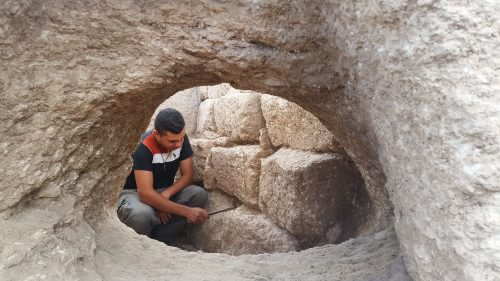Hundreds of teenagers participated in the excavation in Shlomi * The furnace that was used to fire the jars is the only one known in Israel that was completely carved out of rock. The factory was uncovered in archaeological excavations by the Antiquities Authority, before the establishment of a new neighborhood north of the new "Yarit" neighborhood

In an excavation in the settlement of Shlomi in which hundreds of youths participated in the last months, a 1600-year-old workshop for the manufacture of jugs (the Roman period) was discovered, with a furnace that is the only one of its kind in the country for firing the jugs. The workshop was uncovered in archaeological excavations by the Israel Antiquities Authority in Shlomi before the establishment of a new neighborhood north of the new "Yarit" neighborhood, at the initiative of the Israel Lands Authority and the Shlomi local council.
The furnace was discovered as part of a large archaeological excavation that has been going on for about six months, in which hundreds of teenagers from the north volunteered in recent months, and in particular the students of the "Shakhim" high schools in Nahariya and Ort Kiryat Bialik.
The main area of the antiquities site in Shlomi, called "Bat al Jabal", was planned in advance to be an archaeological park, and the current archaeological excavations were conducted at the edges of the site in order to uncover and document the findings on its edges.
Now, it seems that the unique find will be integrated into the park, for the benefit of the general public.
According to Yufa Hoshkar, the director of the excavation on behalf of the Antiquities Authority, "What makes the factory unique is the unique furnace in it, which was carved out of rock - unlike most of the furnaces we are familiar with, which were built of stones, earth and mud. The ancient factory included a water storage system, storage chambers, a furnace, and more.
According to Hushkar, "the kiln was carefully carved, and it has two compartments - a compartment for putting branches into the fire, and another compartment for placing the pottery, which were added under the conditions of the scorching heat. The pottery debris piled up around the kiln indicates that storage jars were produced here that could be transported by land, as well as jars with large handles (amphorae) that were used to store wine or oil, and were exported from the country by sea.
According to Anastasia Shapiro, a geologist at the Israel Antiquities Authority who studies pottery production, "It is possible to explain the quarrying of the rare kiln precisely here, due to the geological conditions that are special to the Shlomi area: here there is kirton rock that is on the one hand soft and therefore suitable for quarrying, and on the other hand - strong enough to hold status".
Archaeological surveys conducted in the past on the site documented the remains of a state building with a gate - probably from the end of the Roman period, at the time that coincided with the period of use of the maker's house. Remains of walls of houses were also located, apparently from the Byzantine period, which - as in the unique furnace, used the natural rock to carve high foundations out of the rock.

One response
In general, it is customary to call the period before 1600 years "the Byzantine period". The year of its beginning is 324, although technically this is the same Roman Empire from Pompey's conquest in 63 BC, which continues to rule here until the Arab conquest in 641.